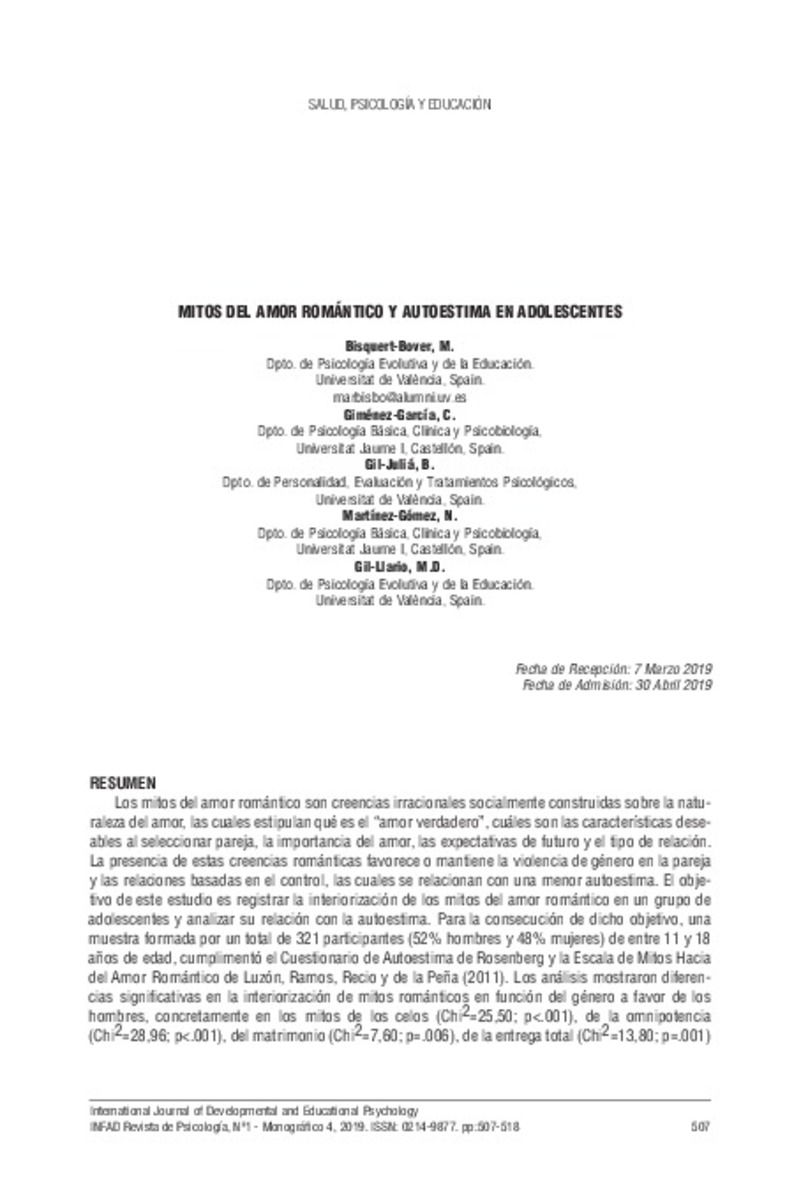Mostrar el registro sencillo del ítem
Mitos del amor romántico y autoestima en adolescentes
| dc.contributor.author | Bisquert-Bover, Mar | |
| dc.contributor.author | Giménez-García, Cristina | |
| dc.contributor.author | GIL JULIA, BEATRIZ | |
| dc.contributor.author | Martínez Gómez, Naiara | |
| dc.date.accessioned | 2022-02-01T14:45:18Z | |
| dc.date.available | 2022-02-01T14:45:18Z | |
| dc.date.issued | 2019-09-01 | |
| dc.identifier.citation | Bisquert-Bover, M., Giménez-García, C., Gil-Juliá, B., Martínez-Gómez, N., & Gil-Llario, M. D. (2019). Mitos del amor romántico y autoestima en adolescentes. Revista INFAD De Psicología. International Journal of Developmental and Educational Psychology., 5(1), 507–518. https://doi.org/10.17060/ijodaep.2019.n1.v5.1633 | ca_CA |
| dc.identifier.issn | 0214-9877 | |
| dc.identifier.issn | 2603-5987 | |
| dc.identifier.uri | http://hdl.handle.net/10234/196575 | |
| dc.description.abstract | Los mitos del amor romántico son creencias irracionales socialmente construidas sobre la naturaleza del amor, las cuales estipulan qué es el “amor verdadero”, cuáles son las características deseables al seleccionar pareja, la importancia del amor, las expectativas de futuro y el tipo de relación. La presencia de estas creencias románticas favorece o mantiene la violencia de género en la pareja y las relaciones basadas en el control, las cuales se relacionan con una menor autoestima. El objetivo de este estudio es registrar la interiorización de los mitos del amor romántico en un grupo de adolescentes y analizar su relación con la autoestima. Para la consecución de dicho objetivo, una muestra formada por un total de 321 participantes (52% hombres y 48% mujeres) de entre 11 y 18 años de edad, cumplimentó el Cuestionario de Autoestima de Rosenberg y la Escala de Mitos Hacia del Amor Romántico de Luzón, Ramos, Recio y de la Peña (2011). Los análisis mostraron diferencias significativas en la interiorización de mitos románticos en función del género a favor de los hombres, concretamente en los mitos de los celos (Chi2=25,50; p menor que .001), de la omnipotencia (Chi2=28,96; p menor que .001), del matrimonio (Chi2=7,60; p=.006), de la entrega total (Chi2=13,80; p=.001) y en los grupos de mitos “El amor es lo más importante y requiere entrega total” (Chi2=33,80; p menor que .001), “Amor como posesión y exclusividad” (Chi2=26,59; p menor que .001) y “El amor lo puede todo” (Chi2=25,19; p menor que .001). Por otro lado, se observa en el total de la muestra una relación significativa e inversa entre la autoestima y el grupo de mitos “el amor lo puede todo” (rho=-.121*) y los mitos de la omnipotencia (rho=-.121*) y exclusividad (rho=-.128*). A la vista de dichos resultados se concluye, por un lado, que los hombres asumen más creencias románticas que las mujeres y por otro, que las personas con menor autoestima presentan una mayor interiorización de las creencias románticas. En base a dichas conclusiones, tanto las diferencias entre géneros por lo que respecta a la interiorización de los mitos románticos como el papel de la autoestima deberían ser considerados en futuras intervenciones. | ca_CA |
| dc.description.abstract | The myths of romantic love are socially constructed upon irrational beliefs about the nature of love, which stipulates what “true love” is, which the desirable characteristics are in a future partner, the importance of love, future expectations and the type of relationship. The presence of these romantic beliefs favours or maintains gender violence within the couple and constitutes the essence of control-based relationships, which are mainly characterized by lower self-esteem. The purpose of this study is to consider the internalization of the myths of romantic love among a group of adolescents and to analyse their relationship in relation with their self-esteem. To achieve this objective, a sample of 321 participants (52% men and 48% women), amongst 11 and 18 years of age, completed the Rosenberg Self-Esteem Questionnaire and the Romantic Love Myths Scale, by Luzón, Ramos, Recio and De La Peña. The analysis showed significant differences in the internalization of romantic myths according to the gender in favour of man, specifically in the miths of jealousy (Chi 2=25,50; p<.001), omnipotence (Chi 2=28,96; p<.001), marriage (Chi 2=7,60; p=.006), total submission (Chi 2=13,80; p=.001) and in the groups of myths “Love is the most importat and requires total delivery” (Chi 2=33,80; p<.001), “Love as possession and exclusivity” (Chi 2=26,59; p<.001) and “Love can do anything” (Chi 2=25,19; p<.001). On the other hand, is observed in the total sample a significant and inverse relationship between self-esteem and the group of myths “Love can do everything” (rho=-.121*) and the myths of omnipotence (rho=-.121*) and exclusivity (rho=-.128*). In view of these results, two conclusions are reached. On the one hand, that men assume more romantic beliefs than woman. On the other hand, that people with lower self-steem have a stronguer internalization of romantic beliefs. Based on these findings, both differences between genders about the internalization of romantic myths and the role of self-esteem should be considered in future interventions. Keywords: romantic love; myths; gender; self-esteem | ca_CA |
| dc.format.extent | 12 p. | ca_CA |
| dc.format.mimetype | application/pdf | ca_CA |
| dc.language.iso | spa | ca_CA |
| dc.publisher | Asociación INFAD | ca_CA |
| dc.relation.isPartOf | International Journal of Developmental and Educational Psychology INFAD Revista de Psicología, Nº1 - Monográfico 4, 2019. ISSN: 0214-9877. pp:507-518 | ca_CA |
| dc.rights.uri | http://creativecommons.org/licenses/by-nc-nd/4.0/ | ca_CA |
| dc.subject | amor romántico | ca_CA |
| dc.subject | mitos | ca_CA |
| dc.subject | género | ca_CA |
| dc.subject | autoestima | ca_CA |
| dc.subject | romantic love | ca_CA |
| dc.subject | myths | ca_CA |
| dc.subject | gender | ca_CA |
| dc.subject | self-esteem | ca_CA |
| dc.title | Mitos del amor romántico y autoestima en adolescentes | ca_CA |
| dc.type | info:eu-repo/semantics/article | ca_CA |
| dc.identifier.doi | https://doi.org/10.17060/ijodaep.2019.n1.v5.1633 | |
| dc.rights.accessRights | info:eu-repo/semantics/openAccess | ca_CA |
| dc.type.version | info:eu-repo/semantics/publishedVersion | ca_CA |
Ficheros en el ítem
Este ítem aparece en la(s) siguiente(s) colección(ones)
-
PSB_Articles [1325]
Articles de publicacions periòdiques








